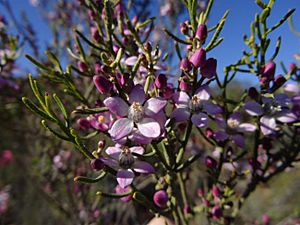Narrow-leaf wax-flower facts for kids
Quick facts for kids Narrow-leaf wax-flower |
|
|---|---|
 |
|
| Philotheca brucei near Paynes Find | |
| Scientific classification | |
| Genus: |
Philotheca
|
| Species: |
brucei
|
| Synonyms | |
|
Eriostemon brucei F.Muell. |
|
Philotheca brucei is a type of flowering plant found only in Western Australia. It belongs to the citrus family, called Rutaceae. This plant is a shrub with cool, tube-shaped leaves. In spring, it grows beautiful white, pink, or purple flowers. Each flower has five petals shaped like an egg.
Contents
What Does It Look Like?
Philotheca brucei is a shrub that can grow up to 2 meters (about 6.5 feet) tall. It has straight branches.
Its leaves are thin and shaped like tubes or narrow ovals. They can be up to 15 millimeters (about half an inch) long. The top of the leaves is often curved inwards, like a dish or channel. Sometimes, these leaves are covered with tiny, star-shaped hairs.
The flowers grow one by one on a small stalk called a pedicel. This stalk is usually less than 4 millimeters long. Each flower has five round, slightly thick parts called sepals, which are about 1 millimeter long.
The five petals are broadly egg-shaped and smooth. They can be white, light pink, or even a light purple color. Each petal is about 4.5 millimeters long. Inside the flower, there are ten stamens. Each stamen has a part called an anther, which is about 0.5 to 1 millimeter long.
How It Was Named
This plant was first officially described in 1869 by a scientist named Ferdinand von Mueller. He gave it the name Eriostemon brucei. He published his description in a book called Fragmenta phytographiae Australiae.
The second part of the name, brucei, was chosen to honor John Bruce. He was a British Army officer who served as acting governor of Western Australia for a time.
Later, in 1970, another scientist named Paul Wilson studied this plant more closely. He described three different types, or subspecies, of Philotheca brucei. These descriptions were published in a science journal called Nuytsia.
In 1990, Paul Wilson moved Eriostemon brucei into a different group of plants called Philotheca. So, its new name became P. brucei. He also moved the three subspecies into the Philotheca group. These names are now accepted by the Australian Plant Census.
Different Types of Philotheca brucei
- Philotheca brucei subsp. brevifolia: This type has leaves that are very hairy and only about 1.5 millimeters long.
- Philotheca brucei subsp. brucei: This type has leaves that are mostly tube-shaped and become smooth when they are fully grown.
- Philotheca brucei subsp. cinerea: This type has oblong (oval-shaped) leaves that are covered in dense hairs.
Where It Grows
Each subspecies of Philotheca brucei grows in slightly different places in Western Australia.
- Subspecies brevifolia can be found on rocky hills between Paynes Find and Sandstone.
- Subspecies brucei grows on rocky hills and steep slopes called breakaways. These areas are within 500 kilometers (about 310 miles) of the west coast of Western Australia.
- Subspecies cinerea grows on laterite breakaways. Laterite is a type of soil and rock. This subspecies is found near the upper Murchison River.
Is It Endangered?
All three subspecies of Philotheca brucei are considered "not threatened" by the Western Australian Government's Department of Parks and Wildlife. This means they are not currently at risk of disappearing.

